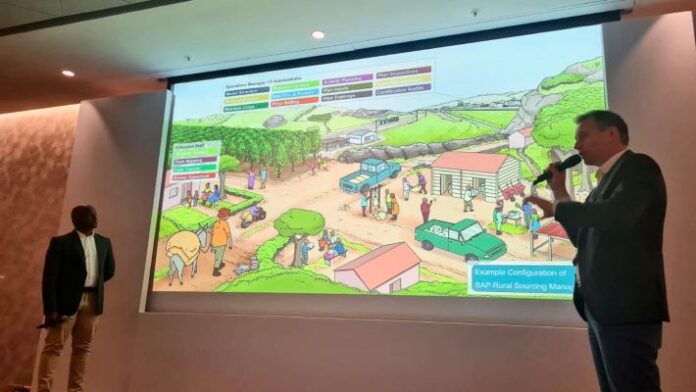We are living in times of continuous disruption, including issues such as economic instability, supply chain and shipping disruptions, and the after-effects of extreme weather events caused by climate change. These ongoing disruptions are all having a significant impact on the ways that organisations run their businesses.
Companies today therefore require digital transformation in real time to process their data and be empowered with prediction capabilities – all of which is enabled by artificial intelligence (AI).
This is according to Thomas Pfiester, Head of Global Customer Engagement & Services and a Member of the Extended Board, SAP. He was co-presenting a keynote address recently at SAPHILA 2025, the bi-annual conference of the African SAP User Group (AFSUG), which was held at Sun City Resort in South Africa’s North West Province at the beginning of June.
Pfiester said that a more holistic approach to business – one which seamlessly combines business processes, applications and people, with AI embedded throughout the technology – can speed up an organisation’s business transformation to the cloud. In this article, we discuss the information presented at this keynote address, as well as looking at two additional African case studies which show how SAP technology can support and enable an organisation’s cloud transformation journey.
Enabling cloud transformation with tools, architecture and competencies
“We are in the middle of an AI revolution, and innovation must flow through the business,” said Pfiester. “Transformation is about more than just tools; it also includes methodology and competencies. Disruption has impacted on the ways with which we run our businesses, and the advantages of agility have become a necessity.
“Against this background, SAP can help you build transformation within your organisation as a ‘corporate muscle’. SAP has all the required factors for the transformation journey with regards to tools, architecture and competencies. We advise businesses to engage with the SAP Enterprise Architects Team when they are considering moving to the cloud, to assist with bringing a transformation mindset throughout the business.”
SAP Enterprise Architects are high-level IT professionals who design, implement and manage SAP solutions within an organisation, ensuring that they align with both business goals and IT strategy, and act as a bridge between business needs and technical implementation.
Pfiester explained that the ‘RISE with SAP’ methodology, designed to help SAP ERP customers to migrate to SAP Business Suite (S/4 HANA) in the cloud, incorporates the following benefits:
- SAP’s AI co-pilot, Joule,is embedded throughout the technology;
- New dashboard releases are presented to support the transformation, providing organisations with significant information such as ‘clean core’ compliance, data collection and system upgrades;
- A Clean Core concept and tool chain is incorporated, which involves minimising modifications to the core SAP system, and instead making use of cloud platforms such as SAP BTP for custom requirements; and
- Enterprise Architects play a key role by working closely with various stakeholders, including business leaders and customers, to share their deep understanding of SAP systems.
“SAP has additionally embraced some key new partnerships to help our customers address their business challenges,” added Pfiester, “including connecting SAP’s Joule with Microsoft’s Copilot, a partnership with Ali Baba for companies in China, and a partnership with Perplexity search engine together with Joule, to name but a few new interfaces. The intention is to continue to harness power from available and existing non-SAP AI tools and search engines.”
Coaching organisations to become future-ready
Pfiester’s input was supported by additional information presented by Johannes Langguth, Global Head of Business Transformation and Architecture, SAP, who began by reminding the delegates that: “Our role is to provide help and guidance early on in your transformation journey to the cloud, which unlocks significant business capabilities. At SAP, we want to be your coaches to get your organisation future ready.
“In this regard, our Enterprise Architects provide your business with the following advantages in your transformation journey: stability with scalability; alignment with agility; and the ability to unlock insights over instinct. In short, Enterprise Architects help to create significant visibility of where you are, to help you define the path you wish to follow, using the options within your SAP solution portfolio.”
Additionally, Langguth advised that adhering to Clean Core principles unlocks significant benefits, as follows:
- Increased innovation adoption: By enabling frequent and easier upgrades;
- Improved business productivity: Through recommending business process improvements;
- Better IT agility and resilience: By empowering IT to respond faster to new business needs and keeping the landscape secure; and
- Enhanced IT spend effectiveness: Through allowing the shift of IT spend on technical debt management to innovation projects.
According to Langguth: “At SAP, we believe that AI needs to be everywhere, and so it is also in our tool chain in an omnipresent manner. This helps to unlock value in four key dimensions, as follows: through reducing the costs of transformation by up to 30 percent; enabling up to 35 percent faster time-to-business value; increasing business agility by up to 70 percent; and facilitating up to 40 percent faster continuous innovation. It all speaks to the fact that, in the cloud era, transformation is significantly speedier than before.”
Having discussed the advantages that can be brought to a business through its transformation to the cloud, it is of particular interest to look at two practical case studies that were presented to SAPHILA delegates from within southern Africa, namely Eswatini and Zimbabwe.
SAP ‘sweetens the deal’ in Eswatini cloud transformation journey
During a presentation entitled ‘Expanding Public Cloud ERP with SAP Success Factors’, delegates heard from Nick Jackson, CEO of the Royal Eswatini Sugar Corporation, how SAP had assisted the organisation with its route to the cloud, to simplify the challenges and operations that were to be found within a complex business that plays a significant role within its national economy.
Jackson stated: “As a company, the Royal Eswatini Sugar Corporation contributes around eight percent of the country’s GDP. In addition to growing sugar, we also produce ethanol, and we farm cattle. We are responsible for housing around 30,000 people and, as such, are also involved in running schools and healthcare clinics, with significant community involvement.
“The company itself is quite complicated and diverse in its operations. For example, we run two mills within one company, which both operate according to different tax regimes. Within this complexity, we saw our journey to the cloud as ultimately being inevitable. We worked very hard on change management as a key part of the process, to try to ensure that everyone was on board, and we used a phased approach to reduce implementation risk.”
Jackson noted that, as a result of a hugely successful pilot project, a decision was then taken to carry out a full migration to the cloud of all the Royal Eswatini Sugar Corporation’s applications. “Having held a vote among key participants, we chose to go with the public cloud rather than using a private cloud – that decision was unanimous. Another decision taken was that, having configured our previous system ‘to death’, we wanted to ensure that we didn’t do this again. We therefore ensured that our SAP implementations would remain standardised.”
Jackson commented that principles and standards adopted by the Royal Eswatini Sugar Corporation during its move to the cloud included the following:
- Software-as-a-service principle: If the software was available on the cloud, the company would use the cloud app.
- No ‘big bang’ implementation: An agile, nimble approach to projects and programs was followed.
- Business-led transformation: It was important that the business must own and lead the digital transformation.
- All decisions must be aligned to the corporate strategy: This was the golden thread followed throughout the programme.
- Standardisation: The company would adapt business processes to fit the system, and not the other way around.
“We’ve now successfully transitioned to the public cloud with S4 / HANA,” concluded Jackson. “Everything is stable after a complex transition with multiple moving parts. We are now looking to explore the value brought by the cloud and are keen to see the benefits that the technology’s embedded AI will bring.”
‘Smoking out’ challenges and solutions with SAP in Zimbabwe’s tobacco industry
Staying with a farming-based scenario, albeit looking at a very different crop, delegates were able to hear from Tatenda Mandeya, Group IT Manager, Northern Tobacco, together with Carsten Friedland, Product Manager SAP Rural Sourcing Management, SAP, how sustainability in tobacco sourcing in rural Zimbabwe is being supported through mobile solutions powered by a cloud platform.
Mandeya explained that Northern Tobacco is one of the top five tobacco contracting companies operating within Zimbabwe, today working with around 100 commercial growers and some 4,500 small-scale farmers, to grow tobacco over a combined area of 10,207 hectares. Its operations in total translate to around 15 percent of the total green leaf tobacco crop purchased in the country, with the second highest price to market.
To facilitate a quality crop collection, Northern Tobacco procures and distributes all the necessary inputs required for the farmers to grow the tobacco, including fertilisers, chemicals, fuel and cash for wages.
“Northern Tobacco has a highly skilled staff base, including specialists to support the farmers,” disclosed Mandeya, “and this model has been in existence for around 20 years. It’s important to note that it incorporates environmental, social and governance (ESG) factors such as the chemicals used in the growing process, social impacts on the growers, and the traceability of the crops.”
Friedland explained that SAP’s Rural Sourcing Management had been implemented within Northern Tobacco to assist with digitising the first mile for sustainable sourcing. This involves the following:
- Innovative mobile applications for digital traceability in the informal agricultural sector.
- The recording and synchronising of high-volume transactions– such as registering the farmer, mapping, training attendance, inspection surveys, input supplies, purchases, logistics and payments – in the field in real time via smart phone.
- Further applications support data analysis, facilitate operational field support and ensure traceability.
- Digital track records serve as a basis for regulatory compliance, sustainability certification and services to first mile actors.
“SAP is providing mobile solutions powered by a cloud platform to create digital track records for the small farmers,” Friedland said. “The project scope encompasses grower contracting and registration; ESG surveys, training and case management; farm / plot mapping; field activities; input distribution and farmers’ balances and loan statements.”
Friedland outlined that the Android smartphone app for the field agents is low tech and easy to use. The solution, which is standalone and does not require any previous SAP infrastructure, can also be used in challenging environments with regards to infrastructure and bandwidth: “We assume mostly offline usage and that the field agents will occasionally synch online,” he said.
“You do need connectivity to plan your activities in the field via a web app. As for the analytics, this solution is built on SAP BTP, so we have a direct link to SAP’s cloud analytics, which can showcase the plots of all the participating farmers.”
Mandeya added: “The activity of the farmers can be volatile from one year to the next and the solution helps in following this, which in turn plays a key role in tracking the sourcing of our tobacco. With the implementation of the SAP solution, these turnaround times have improved significantly.”
When seen against the context of these two examples of successful business enablement with SAP within Zimbabwe and Eswatini, it is fitting to close with words from Pfiester when he concluded, in his keynote presentation: “SAP is here to help you go from where you are today, to where you need to be tomorrow.
“Our customers are not alone on their journeys to cloud transformation: we understand that it’s a process as well as a necessity. At SAP, we – together with our partners – are committed to your success.”
For more information on the African SAP User Group (AFSUG), or to become an AFSUG member, please visit https://afsug.com/membership-information/.








